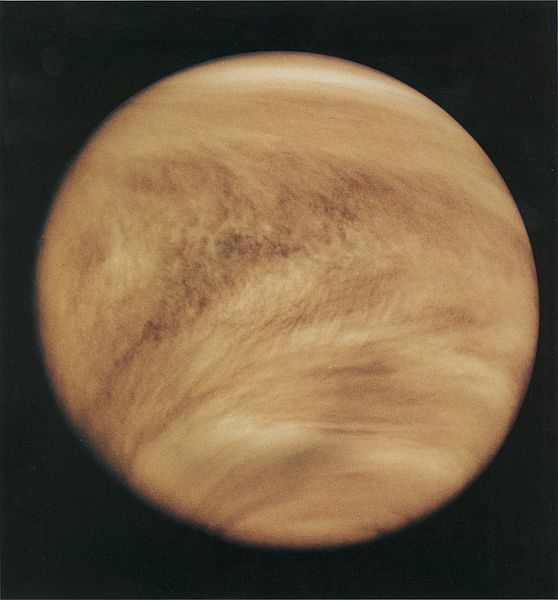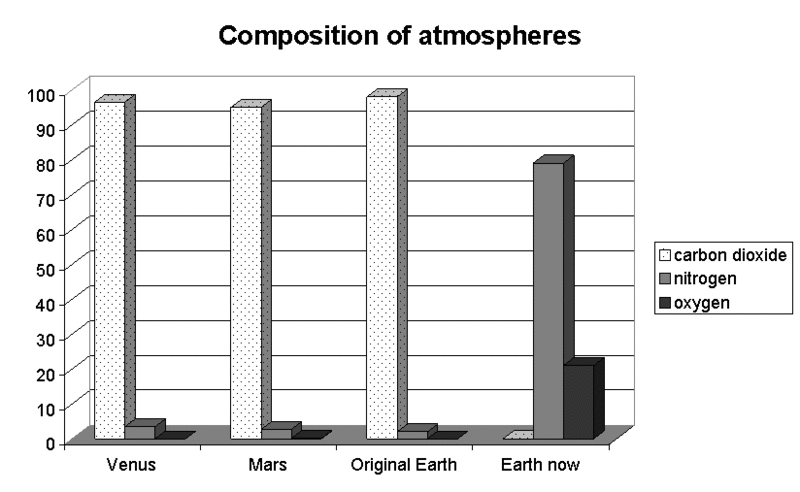The Atmosphere of Venus

Cloud structure in Venus's atmosphere in 1979,
revealed by ultraviolet observations from Pioneer Venus Orbiter
Details of the Image above (Venus)
- Height - 250 km (160 mi)
- Average surface pressure - 93 bar or 9.3 MPa
- Mass - 4.8 × 1020 kg
- Carbon dioxide - 96.5 %
- Nitrogen - 3.5 %
- Sulfur dioxide - 150 ppm
- Argon - 70 ppm
- Water vapour - 20 ppm
- Carbon monoxide - 17 ppm
- Helium - 12 ppm
- Neon - 7 ppm
- Hydrogen chloride - 0.1–0.6 ppm
- Hydrogen fluoride - 0.001–0.005 ppm
The atmospheric environment of Venus is the layer of gases surrounding Venus. It is composed basically of carbon-dioxide and it is much denser and hotter than that of planet Earth. The temperature at the surface is 740 K (467 °C, 872 °F), and the pressure is approximately 93 bar (9.3 MPa), roughly the pressure found 900 m (3,000 ft) underwater on Earth.
The Venusian atmosphere also supports opaque clouds made of sulfuric acid, thereby making optical Earth-based and orbital observation of the surface ptactically impossible. The Information about the topography has been obtained solely by radar imaging.
Aside from carbon dioxide, the other major component is nitrogen. Other chemical compounds are present only in trace numbers.
Unlike Earth, Venus lacks a magnetic field. Its ionosphere separates the atmosphere from the outer space and the solar wind. This ionised layer therefore excludes the solar magnetic field, giving Venus a separate magnetic environment.
This is globally considered as Venus's induced magnetosphere. Lighter gases & water vapour, are constantly blown away by the solar wind through the induced magnetotail. It was forecasted that the atmosphere of Venus up to around 4 billion years ago was more like that of the Earth with liquid water on the surface.
Even in the midst of the harsh conditions on the surface, the atmospheric pressure and temperature at about 50 km to 65 km above the surface of the planet has been proven to be nearly the same as that of the Earth, thereby making its upper atmosphere the most Earth-like region in the Solar System, even more so than the surface of Mars.
Let's take a brief look at its History:
Mikhail Lomonosov, by history, was the first person to have a deep thought to eventually hypothesize the existence of an atmosphere on Venus. based on his observation of the transit of Venus of 1761 in a small observatory near his house in Saint Petersburg, located in Russia.
Composition of the atmosphere of venus and its comparison to other atmospheres

Composition of the atmosphere of Venus. The chart on the right is an expanded view of the trace elements that all together do not even make up a tenth of a percent
The atmosphere of Venus is typically composed of 96.5% carbon dioxide, 3.5% nitrogen, and traces of other gases, most notably sulfur dioxide. The amount of nitrogen in the atmosphere is relatively small when compared to the amount of carbon dioxide, but because the atmosphere is so much thicker than that on Earth, its total nitrogen content is just four times higher than Earth's nitrogen although Earth's nitrogen makes up about 78% of the atmosphere.

Comparison of Atmosphere Compositions – Venus, Mars, Earth (past and present)
Going further, The atmosphere contains a range of interesting compounds in small amount of quantity, including some based on hydrogen, such as hydrogen chloride (HCl) and hydrogen fluoride (HF).
There is carbon monoxide, water vapour and atomic oxygen also. Hydrogen is short in supply in the Venusian atmosphere.
A substantial amount of the planet's hydrogen is theorised and proven to have been lost to space, with the remainder being bound up in sulfuric acid (H2SO4) and hydrogen sulfide (H2S).
The loss of significant amounts of hydrogen is proven by a very high D–H ratio measured in the Venusian atmosphere.
Source
There is reasonable evidence that this article has been spun, rewritten, or reworded. Repeatedly posting such content is considered spam.
Spam is discouraged by the community, and may result in action from the cheetah bot.
More information and tips on sharing content.
If you believe this comment is in error, please contact us in #disputes on Discord
This post has been rewarded with 30% upvote from @indiaunited-bot account. We are happy to have you as one of the valuable member of the community.
If you would like to delegate to @IndiaUnited you can do so by clicking on the following links: 5SP, 10SP, 15SP, 20SP 25SP, 50SP, 100SP, 250SP. Be sure to leave at least 50SP undelegated on your account.
Please contribute to the community by upvoting this comment and posts made by @indiaunited.
Hello, please be informed that there's need to reference your sources of information when writing content such as this.
Read here and here to see the guidlines on creating STEM content.
You can also join the stemstem community on discord to learn more.
Nice one geologist
thanks man